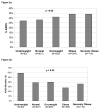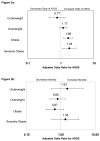Body mass index is associated with the development of acute respiratory distress syndrome
- PMID: 19770169
- PMCID: PMC3090260
- DOI: 10.1136/thx.2009.117572
Body mass index is associated with the development of acute respiratory distress syndrome
Abstract
Background: The relationship between body mass index (BMI) and development of acute respiratory distress syndrome (ARDS) is unknown.
Methods: A cohort study of critically ill patients at risk for ARDS was carried out. BMI was calculated from admission height and weight. Patients were screened daily for AECC (American European Consensus Committee)-defined ARDS and 60-day ARDS mortality.
Results: Of 1795 patients, 83 (5%) patients were underweight (BMI <18.5 kg/m(2)), 627 (35%) normal (BMI 18.5-24.9), 605 (34%) overweight (BMI 25-29.9), 364 (20%) obese (BMI 30-39.9) and 116 (6%) severely obese (BMI > or =40). Increasing weight was associated with younger age (p<0.001), diabetes (p<0.0001), higher blood glucose (p<0.0001), lower prevalence of direct pulmonary injury (p<0.0001) and later development of ARDS (p = 0.01). BMI was associated with ARDS on multivariate analysis (OR(adj) 1.24 per SD increase; 95% CI 1.11 to 1.39). Similarly, obesity was associated with ARDS compared with normal weight (OR(adj) 1.66; 95% CI 1.21 to 2.28 for obese; OR(adj) 1.78; 95% CI 1.12 to 2.92 for severely obese). Exploratory analysis in a subgroup of intubated patients without ARDS on admission (n = 1045) found that obese patients received higher peak (p<0.0001) and positive end-expiratory pressures (p<0.0001) than non-obese patients. Among patients with ARDS, increasing BMI was associated with increased length of stay (p = 0.007) but not with mortality (OR(adj) 0.89 per SD increase; 95% CI 0.71 to 1.12).
Conclusion: BMI was associated with increased risk of ARDS in a weight-dependent manner and with increased length of stay, but not with mortality. Additional studies are needed to determine whether differences in initial ventilator settings may contribute to ARDS development in the obese.
Figures



References
-
- Kopelman PG. Obesity as a medical problem. Nature. 2000;404:635–43. - PubMed
-
- Flegal KM, Graubard BI, Williamson DF, Gail MH. Excess deaths associated with underweight, overweight, and obesity. JAMA. 2005;293:1861–7. - PubMed
-
- National Center for Health Statistics. Health, United States 2003. Hyattsville, MD: National Center for Health Statistics; 2003.
-
- Newell MA, Bard MR, Goettler CE, et al. Body mass index and outcomes in critically injured blunt trauma patients: weighing the impact. J Am Coll Surg. 2007;204:1056–61. discussion 62-4. - PubMed
-
- Joffe A, Wood K. Obesity in critical care. Curr Opin Anaesthesiol. 2007;20:113–8. - PubMed
Publication types
MeSH terms
Grants and funding
LinkOut - more resources
Full Text Sources
Medical
